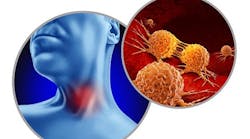Impacting nearly one in three American adults, xerostomia has a myriad of etiologies, including but not limited to medications, aging, cancer therapy, autoimmune disorders, tobacco dependence, alcohol usage, and nerve damage, to name a few.1
It is well understood that a compromised salivary flow can impact the antimicrobial, digestive, and buffering effects of the oral cavity, influencing risk for various oral diseases such as caries and periodontal disease. However, the systemic impacts of xerostomia are now being critically evaluated, and of great interest is the resulting digestive problems implicated by xerostomia conditions.
Put simply, xerostomia is no longer a condition impacting the oral cavity alone. The journey food takes within the digestive system may provide key clues as to how dental health-care practitioners are now called upon to actively address this unique oral-systemic link.
Saliva and digestion
In an unstimulated state, the salivary glands should (and should is the key word) maintain lubrication to the oral surfaces. The secretion of saliva is a reflex, activated in response to ingestion of foods and beverages.2 With the gentle bite of food or sip of a beverage, a mixed fluid of mucin, minerals, enzymes, and other secretory components pours from the gland and into the mouth, bathing the teeth and oral mucosa.
It is worth noting that saliva can also be stimulated by things such as stretching receptors of the stomach due to nausea/vomiting or through olfactory receptors stimulated by odors; even dogs have demonstrated that the sensation of drooling can occur simply at the sight of appetizing foods. Nevertheless, upon interacting with foods or beverages, the body should increase sensory signaling and therefore send pools of watery saliva through the salivary ducts and into the oral cavity.
You may also be interested in ... Treating patients with eating disorders
From there, saliva begins coating our food bolus with salivary mucin, a component of saliva that acts as a lubricant, smoothly clearing food debris and making it suitable for easy swallowing. The saliva also releases digestive enzymes that help begin the digestive process, particularly in initiating the digestion of starches via salivary amylase and the early breakdown of dietary fats by lingual lipase. Additional components of the saliva assist with clearing smaller food debris particulates, dissolving foods, and diluting overt sensations such as that observed in peppers and spicy food.3
With age, the number of chew cycles required before swallowing increases as the coordinated efforts of the muscles of mastication require ample saliva before food debris is eventually cleared.4 With the help of sodium bicarbonate, the food bolus pH is neutralized to an optimal 7.0 prior to passage through the food pipe, also termed the esophagus.
Xerostomia and digestive disorders
In the case of salivary gland hypofunction, the delicate process of digestion begins with an incredible error.
First, the lack of saliva begins creating an impairment of oropharyngeal functions, leading to difficulty in chewing and swallowing. In many cases, this disruption can lead to behavioral changes in food choices, moving to preferences of soft and carbohydrate-rich foods and avoiding dry, crunchy, or tuberous foods that are often more nutrient-dense.
Secondly, declined salivary flow disturbs the perception of taste, flavor, and food texture, which often manifests as loss of appetite, particularly in the aging patient population.5 For patients who may be immunocompromised or already suffer from malabsorption complications due to medications, this finding can be quite concerning.6
You may also be interested in ... A pain in the gut: Understanding irritable bowel syndrome and its dental implications
Finally, the disturbances in being able to break down foods via digestive enzymes can dramatically impact food intake and subsequent nutritional absorption. Clinical manifestations can range from nutritional deficiencies, weight loss, malabsorption, and even atrophy of the masticatory muscles leading to impaired chewing performance.7
Put simply, the early portion of the digestive system is deeply dependent on sample amounts of saliva to assist with digestion, and any interruption of the digestive system—particularly in the entryway—can cause a cascade of events that leave our cotton-mouthed patients at potential risk for systemic complications around digestion and nutrient absorption.8
The clinical application
As research continues to unpack the various ways in which xerostomia may impact digestion and subsequent nutrient absorption, the dental community is now called upon to treat more than simply the oral sequelae of xerostomia.
While remineralization therapy addresses the caries risk, and shifting mouth rinse recommendations to a nonalcohol-containing product can prevent periodontal issues in a patient experiencing xerostomia, it is important to note that saliva stimulation and/or replacement is another ideal therapy aimed at addressing the potential digestive complications of xerostomia.
Saliva replacements can aid in many of the functional aspects of chewing, while habits like chewing sugar-free gum, sucking on ice cubes, or introducing xylitol into an oral health-care regimen can even stimulate salivary flow. Nevertheless, this clinical approach involves not only addressing the aftermath of xerostomia, which may include buffering or remineralization therapy, but also the complication of a compromised salivary flow as it pertains to systemic disease.
Conclusion
One thing is certain: as long as our patient populations continue to experience dry mouth, research will continue spitting out new data on saliva’s critical role in systemic health. As oral health-care practitioners, our role is to continue to identify our responsibility to oral health and address and support systemic health through our critical work.
Editor's note: This article appeared in the August 2023 print edition of RDH magazine. Dental hygienists in North America are eligible for a complimentary print subscription. Sign up here.
References
- Agostini BA, Cericato GO, da Silveira ER, et al. How common is dry mouth? Systematic review and meta-regression analysis of prevalence estimates. Braz Dent J. 2018;29(6):606-618. doi:10.1590/0103-6440201802302
- Hector MP, Linden RWA.Reflexes of salivary secretion. In: Garrett JR, Ekström J, Andersson LC, eds. Neural mechanisms of salivary gland secretion. Frontiers of Oral Biology. S. Karger AG; 1999:196-217. https://doi.org/10.1159/000061114
- Pedersen A, Sørensen CE, Proctor GB, Carpenter GH. Salivary functions in mastication, taste and textural perception, swallowing and initial digestion. Oral Dis. 2018;24(8):1399-1416. doi:10.1111/odi.12867
- Liedberg B, Owall B.Masticatory ability in experimentally induced xerostomia. Dysphagia. 1991;6(4):211- 213. doi:10.1007/BF02493529
- Loesche WJ, Bromberg J, Terpenning MS, et al. Xerostomia, xerogenic medications and food avoidances in selected geriatric groups. J Am Geriatr Soc. 1995;43(4):401-407. doi:10.1111/j.1532-5415.1995.tb05815.x
- Crowder SL, Douglas KG, Pepino MY, Sarma KP, Arthur AE. Nutrition impact symptoms and associated outcomes in post-chemoradiotherapy head and neck cancer survivors: a systematic review. J Cancer Surviv. 2018;12(4):479-494. doi:10.1007/s11764-018-0687-7
- Dusek M, Simmons J, Buschang PH, al-Hashimi I. Masticatory function in patients with xerostomia. Gerodontology. 1996;13(1):3-8. doi:10.1111/j.1741-2358.1996.tb00144.x
- Earar K, Fratila DN. Digestive disorders in the oral cavity. Med Mater. 2021;1(1):23-30. doi:10.36868/MEDMATER.2021.01.01.023






